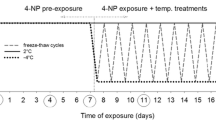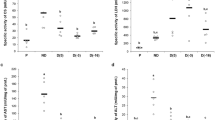Abstract
The Antarctic nematode Panagrolaimus davidi is the best documented example of an animal surviving intracellular freezing and the only animal so far shown to survive such freezing throughout its tissues. However, a recent study found that after exposure to a freezing stress that produced intracellular freezing in a proportion of nematodes, the resulting survival levels could be explained if those nematodes that froze intracellularly had died. We have thus re-examined the survival of intracellular freezing in this nematode. The ability to survive a freezing exposure that is likely to produce intracellular freezing (freezing at −10 °C) declines with culture age. In cultures that are fed regularly, the ability to survive freezing at −10 °C increases, but in starved cultures freezing survival declines. Survival of intracellular freezing in fed cultures was confirmed using cryomicroscopy, staining of cells with vital dyes and by freeze substitution and transmission electron microscopy. We have thus confirmed that P. davidi can survive intracellular freezing and shown that this ability is dependent upon them being well fed. The effect of culture conditions on the nutrient status of the nematodes should thus be an important factor in the design of experiments.







Similar content being viewed by others
Abbreviations
- cfu:
-
Colony forming units
- rpm:
-
Revolutions per minute
- T min :
-
Minimum temperature
References
Ansart A, Vernon P (2003) Cold hardiness in molluscs. Acta Oecol-Int J Ecol 24:95–102
Brown IM, Wharton DA, Millar RB (2004) The influence of temperature on the life history of the Antarctic nematode Panagrolaimus davidi. Nematology 6:883–890
Costanzo JP, Lee RE, Ultsch GR (2008) Physiological ecology of overwintering in hatchling turtles. J Exp Zool Part A 309:297–379
Grant W, Viney M (2011) The dauer phenomenon. In: Perry RN, Wharton DA (eds) Molecular and physiological basis of nematode survival. CABI Publishing, Wallingford, pp 99–125
Greenaway P (1970) Sodium regulation in the freshwater mollusc Limnaea stagnalis (L) (Gastropoda, Pulmonata). J Exp Biol 53:147–163
Hengherr S, Worland MR, Reuner A, Brümmer F, Schill RO (2009) Freeze tolerance, supercooling points and ice formation: comparative studies on the subzero temperature survival of limno-terrestrial tardigrades. J Exp Biol 212:802–807
Holmstrup M (2003) Overwintering adaptations in earthworms. Pedobiologia 47:504–510
Hooper DJ (1986) Extraction of free-living stages from soil. In: Southey JF (ed) Laboratory methods for work with plant and soil nematodes. HMSO, London, pp 5–30
Issartel J, Voituron Y, Odagescu V, Baudot A, Guillot G, Ruaud JP, Renault D, Vernon P, Hervant F (2006) Freezing or supercooling: how does an aquatic subterranean crustacean survive exposures at subzero temperatures? J Exp Biol 209:3469–3475
Lee RE (2010) A primer on insect cold tolerance. In: Denlinger DL, Lee RE (eds) Low temperature biology of insects. Cambridge University Press, Cambridge, pp 3–34
Lee RE, McGrath JJ, Morason RT, Taddeo RM (1993) Survival of intracellular freezing, lipid coalescence and osmotic fragility in fat body cells of the freeze-tolerant gall fly Eurosta solidaginis. J Ins Physiol 39:445–450
Lewis SC, Dyal LA, Hilburn CF, Weitz S, Liau WS, LaMunyon CW, Denver DR (2009) Molecular evolution in Panagrolaimus nematodes: origins of parthenogenesis, hermaphroditism and the Antarctic species P. davidi. BMC Evol Biol 9:15
Porazinska DL, Wall DH, Virginia RA (2002) Invertebrates in ornithogenic soils on Ross Island, Antarctica. Polar Biol 25:569–574
Sinclair BJ, Renault D (2010) Intracellular ice formation in insects: unresolved after 50 years? Comp Biochem Physiol A-Mol Integr Physiol 155:14–18
Sinclair BJ, Roberts SP (2005) Acclimation, shock and hardening in the cold. J Therm Biol 30:557–562
Smith T, Wharton DA, Marshall CJ (2008) Cold tolerance of an Antarctic nematode that survives intracellular freezing: comparisons with other nematode species. J Comp Physiol B 178:93–100
Stiernagle T (1999) Maintenance of C. elegans. In: Hope IA (ed) C. elegans: a practical approach. Oxford University Press, Oxford, New York, pp 51–67
Storey KB, Storey JM (1988) Freeze tolerance in animals. Physiol Rev 68:27–84
Tursman D, Duman JG, Knight CA (1994) Freeze tolerance adaptations in the centipede, Lithobius fortificatus. J Exp Zool 268:347–353
Voituron Y, Barre H, Ramlov H, Douady CJ (2009) Freeze tolerance evolution among anurans: frequency and timing of appearance. Cryobiol 58:241–247
Wharton DA (2003) The environmental physiology of Antarctic terrestrial nematodes: a review. J Comp Physiol B 173:621–628
Wharton DA (2011) Cold tolerance. In: Perry RN, Wharton DA (eds) Molecular and physiological basis of nematode survival. CABI Publishing, Wallingford, pp 182–204
Wharton DA, Brown IM (1989) A survey of terrestrial nematodes from the McMurdo Sound region, Antarctica. NZ J Zool 16:467–470
Wharton DA, Brown IM (1991) Cold tolerance mechanisms of the Antarctic nematode Panagrolaimus davidi. J Exp Biol 155:629–641
Wharton DA, Ferns DJ (1995) Survival of intracellular freezing by the Antarctic nematode Panagrolaimus davidi. J Exp Biol 198:1381–1387
Wharton DA, Rowland JJ (1984) A thermoelectric microscope stage for the measurement of the supercooling points of microscopic organisms. J Microsc 134:299–305
Wharton DA, Judge KF, Worland MR (2000) Cold acclimation and cryoprotectants in a freeze-tolerant Antarctic nematode, Panagrolaimus davidi. J Comp Physiol B 170:321–327
Wharton DA, Goodall G, Marshall CJ (2003) Freezing survival and cryoprotective dehydration as cold tolerance mechanisms in the Antarctic nematode Panagrolaimus davidi. J Exp Biol 206:215–221
Wharton DA, Mutch JS, Wilson PW, Marshall CJ, Lim M (2004) A simple ice nucleation spectrometer. CryoLetters 25:335–340
Wharton DA, Downes MF, Goodall G, Marshall CJ (2005) Freezing and cryoprotective dehydration in an Antarctic nematode (Panagrolaimus davidi) visualised using a freeze substitution technique. Cryobiol 50:21–28
Worland MR, Wharton DA, Byars SG (2004) Intracellular freezing and survival in the freeze tolerant alpine cockroach Celatoblatta quinquemaculata. J Ins Physiol 50:225–232
Yi SX, Lee RE (2003) Detecting freeze injury and seasonal cold-hardening of cells and tissues in the gall fly larvae, Eurosta solidaginis (Diptera : Tephritidae) using fluorescent vital dyes. J Ins Physiol 49:999–1004
Acknowledgments
We would like to thank Karen Judge and Matthew Downes for technical assistance, the Otago Centre for Electron Microscopy for access to their facilities and Antarctica New Zealand for the support of our Antarctic studies. MRR would like to acknowledge the support of a Kelly Tarlton’s Antarctica New Zealand Scholarship and the Fanny Evans Postgraduate Scholarship for Women. Funding for this study was provided by the University of Otago (PBRF: PL.104033.01.S.FZ.75) and Antarctica New Zealand (event no. KO66).
Conflict of interest
The authors declare that they have no conflict of interest.
Ethical standards
All experiments complied with the current laws of New Zeland.
Author information
Authors and Affiliations
Corresponding author
Additional information
Communicated by I.D. Hume.
Rights and permissions
About this article
Cite this article
Raymond, M.R., Wharton, D.A. The ability of the Antarctic nematode Panagrolaimus davidi to survive intracellular freezing is dependent upon nutritional status. J Comp Physiol B 183, 181–188 (2013). https://doi.org/10.1007/s00360-012-0697-0
Received:
Revised:
Accepted:
Published:
Issue Date:
DOI: https://doi.org/10.1007/s00360-012-0697-0




